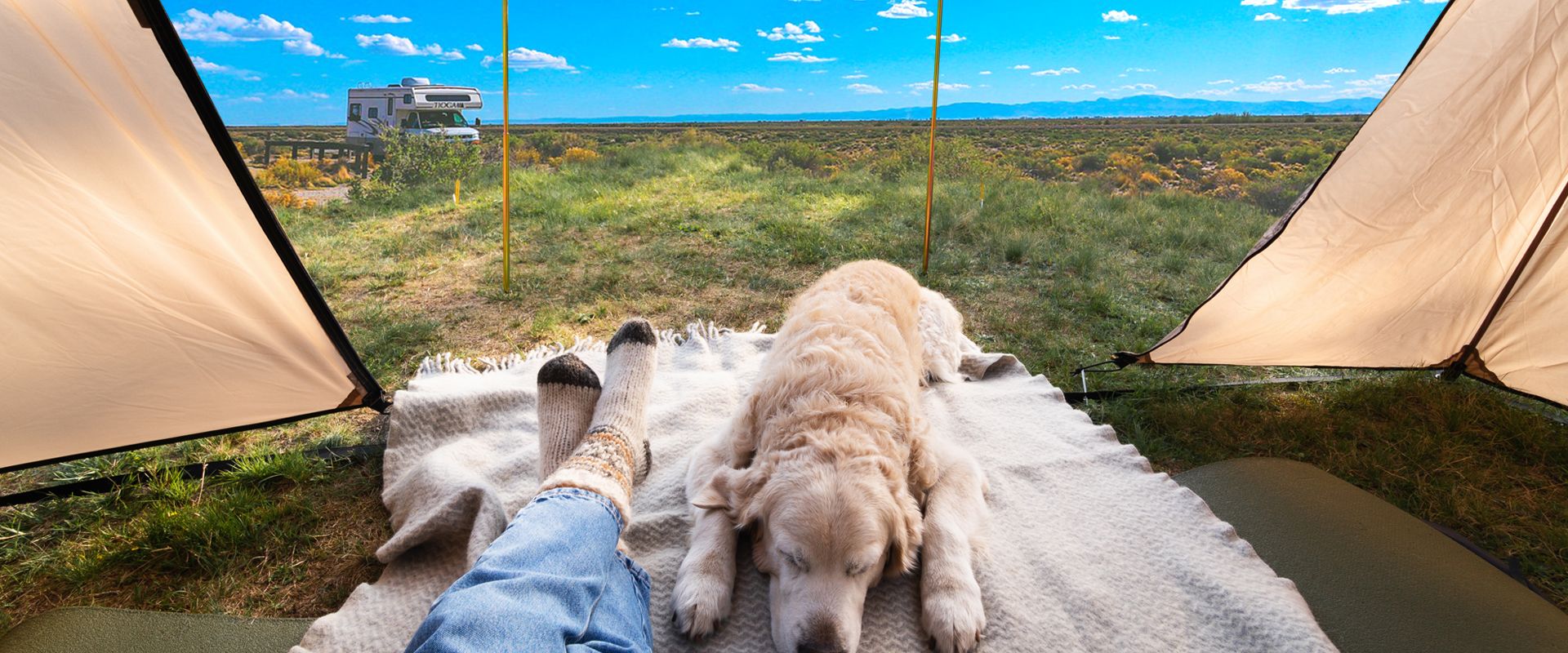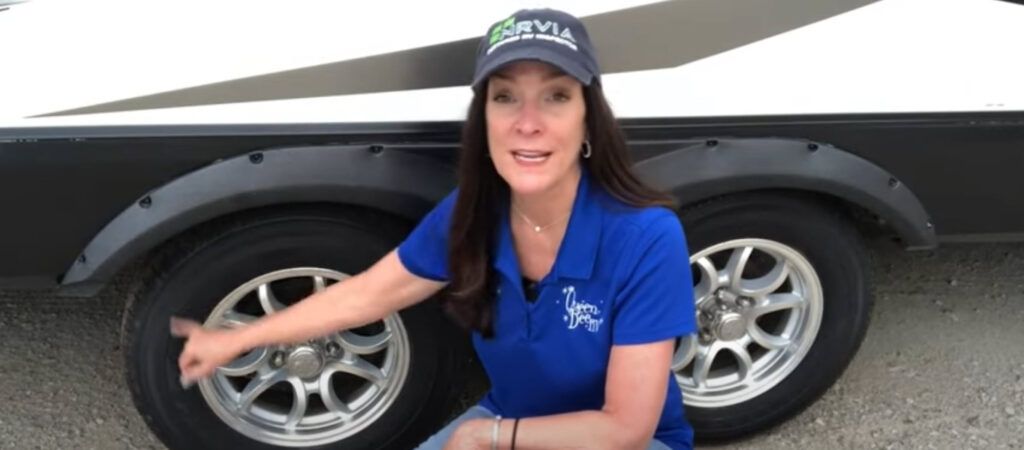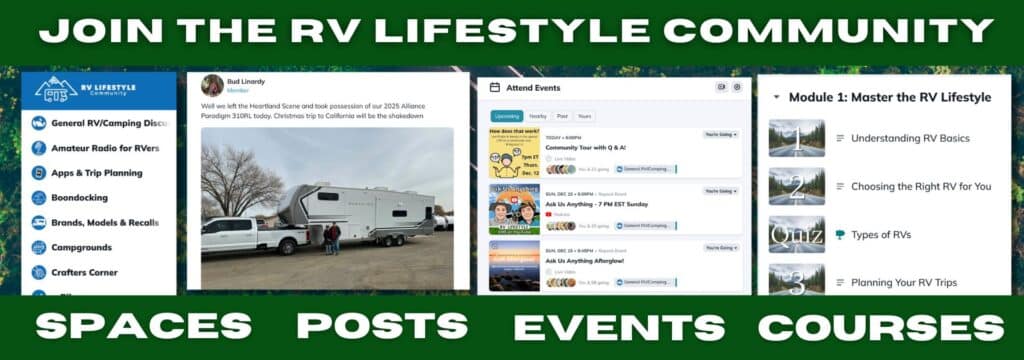How NOT to Lose Your Pet on a Camping Trip (8 Pro Tips)

This article is based on a podcast interview with Annalisa Berns, a real-life pet detective. You can listen to or watch the interview by scrolling to the end, but we have also organized her advice into this article.
As you may know, Jennifer and I have always had a third travel companion during our travels. A very furry travel companion. We would be devastated if we lost Bo out on the road, and we know many fellow RVers share that fear.
So, we asked Annalisa to come on our RV Lifestyle Podcast to give us valuable advice. She shares the following tips on how to prevent losing your pet, and what to do if they manage to get away from you.
What Does a Pet Detective Do?
Our guest is Annalisa Berns, the owner, search dog handler, and licensed private investigator at Pet Search and Rescue. Pet Search and Rescue specializes in helping people find their lost pets, offering coaching and in-person searches primarily in California and Florida.
Annalisa has nearly 20 years of experience finding missing pets and has four active search dogs, Juniper, Rhodie, and Bloodhounds Faith and Hawkeye.
Annalisa, who is a camper who has hiked sections of the Appalachian Trail, has helped many RVers through the years find their lost pet.
Lost Prevention Tips
Camping with pets increases the risk of them going missing due to unfamiliar territories and unforeseen occurrences, such as fireworks or interactions with wildlife. Dogs may get startled by new sounds or chase after an exciting new creature they discoverd.
So, first and foremost, even if your pet stays put at home, don't expect them to while camping!
Tip #1: Consider Their Personalities
The personality of your pet plays a pivotal role in how they might react to unfamiliar or stressful situations. Pets with shy or skittish temperaments are more likely to run away when frightened.
Before planning an outdoor excursion, evaluate your pet's behavior in various situations. If they tend to be anxious or fearful, take extra precautions to ensure their comfort and security.
Tip #2: Keep Your Dog Secured at All Times
Every time you let your dog off-leash, you drastically increase the risk of losing them. Pet detectives often hear, “he never runs away; I don't know what happened” all too often. Annalisa highly recommends keeping your pets on a reliable leash attached to a quality dog harness for camping.
While at the campsite with your dog, contain your dog inside your RV, in a portable dog pen, or on a secure tethering system.
Tip #3: Monitor Your Pet When Left at Campsite
When leaving your pet at the campsite, make sure they can't escape through an open window (many don't have a problem popping out screens!). Double-check that all doors and windows are secure. It's also a good idea to leave your contact information with a camping neighbor in case there's an incident.
If you plan to be gone a long time, consider hiring a pet sitter or using a do monitor. (By the way, here's How to Stop Your Dog or Camping Neighbor’s Dog Barking.)
Tip #4: Keep Them Occupied
Annalisa also discusses how keeping your pet engaged in a safe area can help prevent them from running away. If they have a treat-dispensing dog toy, for instance, they may be less likely to try to escape from your RV.
To keep your dog from trying to run away during a hike (and potentially yanking the leash out of your hand), bring along a stick, ball or favorite toy to recapture their attention as need be.
| Preview | Product | Price | |
|---|---|---|---|

|
KONG Treat-Dispensing Dog Toy |
$14.99 |
Add to Cart |
Tip #5: Train Before Your Camping Trip
Another tip Annalisa shared is to train your dog before your big camping trip. Practice proper leash behavior and coming to you on command.
You can also introduce noises and distractions you may encounter while camping. You can practice on nearby hiking trails or even public parks (**squirrel!!**)
Tip #6: Make Sure Your Pet Wears Identification
Always ensure your pet wears identification tags. Microchipping is recommended, as it is a more permanent form of identification, though the pet needs to be taken to a facility to be scanned.
For immediate location tracking, GPS devices on collars provide real-time updates on your pet’s whereabouts. Many pet owners put Apple Airtags on their pets' collars, which enables Apple users to track them if their pet ventures within range of an Apple device. (Use an AirTag on your RV keys keychain and in your travel pack or purse, too!)
| Preview | Product | Price | |
|---|---|---|---|

|
Apple AirTag 4 Pack | $92.48 | Add to Cart |
| Preview | Product | Price | |
|---|---|---|---|

|
AirTag Dog Collar Holder |
$9.98 |
Add to Cart |
| Preview | Product | Price | |
|---|---|---|---|

|
Apple AirTag Keychain Holder |
$8.99 |
Add to Cart |
What To Do If Your Pet Goes Missing
Sometimes even with preventative measures, our clever pets can still get away. Annalisa shares some very important advice if this happens..
Tip #7: Stay Calm
If your dog gets away from you, stay calm. Annalisa says it's important that you do not chase after or scream at your pet, as that may make them run away faster.
If your dog is running because they're panicked or overly excited, like they're running away from or to wildlife, they might interpret your yelling as panic or encouragement. So, Annalisa says to stay calm.
If your dog is in this heightened state, calmly follow them and keep them in sight as best as possible. This may mean by foot, on a bike, or following them in a car.
She explains that your dog likely won't take off and go for a 3-mile run. They'll likely stay relatively nearby if you're staying calm and following them. Once your dog starts to calm down, call them to you as if you have a treat for them (bonus if you do have a treat).
There is an EXCEPTION to this advice, however! If your dog runs away because of an ongoing trigger, like fireworks, they might cover a long distance in a short time. Every firework, for instance, may make them run faster.
In that case, Annalisa suggests keeping a visual on them as much as possible and to recruit as many helpers as possible. Maybe one person can keep a visual while another goes to get a bike or car.
Tip #7 Recruit a Search Party
If you lose sight of your pet, recruit a search party and notify the local animal control service. However, please be careful not to put other people at risk of getting lost! You don't want to add missing persons to the list, so stay organized and in contact with everyone who is helping you.
Tip #8: Bring in a Professional Pet Detective
If you cannot locate your pet within a short time, it may be time to call in a professional. Annalisa's Pet Search and Rescue primarily works in California and Florida, and pet detective services are limited across the United States.
However, the community of lost pet responders is quickly growing, largely in part due to MissingAnimalResponse.com. This is a worldwide network of missing animal response specialists
On the website, you can search for lost pet responders in your area, and they will quickly come to assist you. The organization also offers professional MAR (Missing Animal Response) training if you want to become part of the network, too.
Be careful of unvetted pet-finding services that you might find on social media or online. These are often scams! That's why Annalisa recommends the highly-trusted MissingAnimalResponse.com.
Don't Let Fear Make You Leave Your Pet at Home
We know the fear of losing a pet can feel overwhelming, but we encourage you to not let that deter you from taking your pet camping. They add so much joy and energy to a camping trip! Just be sure to take all of the precautions Annalisa recommended.
The Podcast Interview
Here is our interview with Annalisa Burns, where she offers expert advice and tells us what to do if our dog runs away on a camping trip.
You can watch the video version from our RV Lifestyle YouTube Channel by clicking the player below.
If you prefer an audio-only podcast, you can hear us through your favorite podcast app or listen now through the player below.
Podcast: Play in new window | Download (Duration: 50:55 — 29.8MB) | Embed
Subscribe: Spotify | TuneIn | RSS
Also on the Podcast…

In addition to Annalisa, certified RV Inspector Brenda of Queen Bee RV shared her tip of the week at the end of the podcast.
Brenda’s focus is on educating RVers on how to care for their RVs – especially women RVers – and she is a regular contributor to the podcast, sharing her expertise with our entire audience.
In this podcast episode, she shared vital tips about RV tires to help you avoid a blowout. Here's what she had to say…
A flat tire or a blowout can strike fear in the heart of any RVer and I know this one from experience. I have had two blowouts while in transit with my Class C motorhome and they are never convenient! Plus, they can be really scary.
Let’s go over some tire care tips so that maybe you can avoid this in your RV adventure…
Always Carry a Tire Gauge
Even if your tires have a like-new appearance or a Seller says that they have barely been driven on, looks can be deceiving and there can be other factors that need your attention.
First, have a good tire gauge with you at all times – either the stick variety or a digital version. I use a digital gauge in my RV inspections and they are much more accurate. Confirm the tire gauge goes high enough for the PSI rating on your RV tires.
Take a pressure reading on every drive, every trip, every time. Do not skip this step. Be sure to take the PSI reading on cold tires. That means the tires have not been driven on right before you check them.
You might also consider installing a TPMS or tire pressure monitoring system.
Know the Age of Your Tires
Know the manufacture dates of all your tires. This can be found by finding the DOT dates on the sidewall of each tire. The NTSB and most tire manufacturers recommend that tires get replaced at the six year mark.
Always Do a Visual Inspection Before Each Trip
Prior to each trip, do a visual inspection of the tread and the sidewalls. For the tread, look for any nails, bald spots, plus signs of over or under inflation. The sidewalls need to be inspected for signs of feathering or cracking, any bulges or other damage.
UV rays can also wreak havoc on your tires, so if possible, keep them covered when exposed to the sun while camping or in storage.
Don’t forget to check your spare, too!
Lastly, when it’s time to replace the tires, it is recommended to do them all at the same time.
App of the Week – Cracker Barrel

Time now for the RV App of the Week segment, taken from the pages of NewTravelTech.com – our sister blog that celebrates the many ways technology enhances the travel experience.
The Cracker Barrel app shows Cracker Barrel locations near you or on your route, many of which allow free overnight stays in the parking lot for RVers.
You can also order take-out meals from restaurants along your route. Allowing you to have it ready by the time you get there.
Cracker Barrel is very friendly to RVers, usually offering plenty of parking even for big rigs.

Tired of Social Media Chaos & AI Madness? Find Solace in Our Authentic RV Lifestyle Community. Over the past year, we've grown into a vibrant space where RVers connect, share trip ideas, swap tips, and troubleshoot challenges together.
Whether you're a seasoned RV traveler or just starting out, this community is the perfect place to connect with fellow explorers, share travel tips, discover amazing destinations, and learn maintenance tricks. Swap stories from the road and build lasting friendships with like-minded adventurers inside this forum-like Community. Join us https://community.rvlifestyle.com
Last update on 2025-04-29 / Affiliate links / Images from Amazon Product Advertising API
